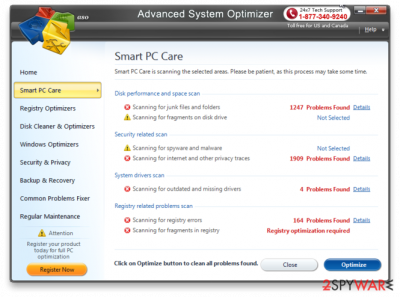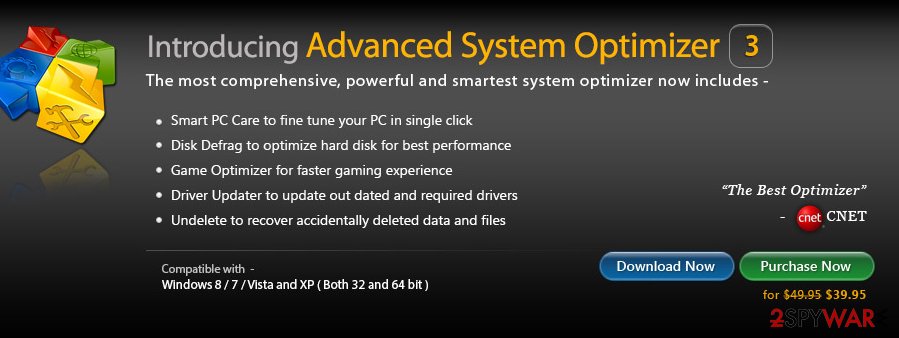Advanced System Optimizer (Improved Instructions) - updated Jan 2021
Advanced System Optimizer Removal Guide
What is Advanced System Optimizer?
Advanced System Optimizer – a system optimizer that shows exaggerated scan results

Advanced System Optimizer (possible versions – 2, 3, v.3.5) by Systweak Inc. is promoted as a PC optimization tool. It is supposed to allow users to deactivate unnecessary processes from running on startup, remove outdated registries, fix potential damage, and so on.
The 2nd version of this tool has been released in 2004 and was definitely successful. More than a million users have left positive feedback and recommended using this optimizer. However, it seems that these days its developers apply unfair marketing strategies seeking to increase the rate of Advanced System Optimizer Version 3 and v.3.5 users.
| Name | Advanced System Optimizer |
| Type | Fake system optimizer, registry cleaner, potentially unwanted program |
| Distribution | Software bundles, third-party websites |
| Alleged functionality | Optimizes system, cleans malware, updates drivers |
| Elimination | You should follow the guide below to uninstall the app manually |
| System fix | In case your system is crashing or delivering errors, you can attempt to fix these issues with an automatic repair tool FortectIntego |
Typically, a trial is attached to various freeware and shareware as an 'additional component' and hidden under Advanced/Custom settings. This way, it may get installed on your machine without asking for appropriate permission. That's why it has been labeled as a potentially unwanted program (PUP).[1]
While the program is legitimate and trustful, users commonly decide to keep it installed even though they haven't downloaded it willingly. According to its developers, the app can perform the following:
- Clean and optimize the system
- Protect and remove malware
- Update drivers automatically.
However, you should keep in mind that the version that is spread by bundling is just a trial, which will not do anything except continuously check your computer, inform you about various issues, and urge you to pay the money ($49.95) for the full version.
Also, Microsoft clearly stated that it does not advise users employing Registry Cleaners:[2]
Microsoft cannot guarantee that these problems can be solved without a reinstallation of the Operating System as the extent of the changes made by registry cleaning utilities varies from application to application.
Continuous system scans may not only burden and slow down your PC's system but may also annoy you to death. Therefore, we highly recommend you to remove Advanced System Optimizer from your machine. If you have never dealt with the uninstallation process before, you should follow the instructions we provide below.

PUPs are often spread via software bundles
You can download a free trial of Advanced System Optimizer from the official website. However, it may also end up on your computer right after installing another freeware. Third parties engage in bundling daily, and this way, they manage to trick hundreds of people into installing such and similar tools daily.
Once installed, Advanced System Optimizer defines an auto-start registry entry in the Windows taskbar and is activated every time you reboot the machine. Therefore, you will continuously experience full system scans and receive reports about the condition of your PC. Nevertheless, the research has shown that most users have removed it a couple of weeks after its installation.
So, it seems that, in reality, the program does not appear to be that useful as promoted. If you want to prevent infiltration of potentially unwanted programs, you should carefully investigate Advanced/Custom settings when installing freeware on your computer. Besides, do not avoid reading EULA, Privacy Policy, testimonials, and other important information related to the freeware you opt for installing.
Ways to remove Advanced System Optimizer
Advanced System Optimize is a legitimate program, which may show up on your computer out of nowhere, check it, and provide you with unasked reports. If you want to get rid of Advanced System Optimize rogue from your machine, you should perform these steps:
- Click Start → Control Panel → Uninstall a Program.
- In the Add/Remove Programs/Uninstall a Program folder look for recently installed/unfamiliar applications, such as Advanced System Optimizer.
- Click 'Uninstall' and then OK to save the changes.
After that, you are strongly advised to run a full system scan with SpyHunter 5Combo Cleaner to check your machine for malware that could be hiding in the background. Besides, if malicious programs were found, you should also use FortectIntego to repair system damage that could have been sustained during virus infection.
You may remove virus damage with a help of FortectIntego. SpyHunter 5Combo Cleaner and Malwarebytes are recommended to detect potentially unwanted programs and viruses with all their files and registry entries that are related to them.
Getting rid of Advanced System Optimizer. Follow these steps
Uninstall from Windows
Instructions for Windows 10/8 machines:
- Enter Control Panel into Windows search box and hit Enter or click on the search result.
- Under Programs, select Uninstall a program.

- From the list, find the entry of the suspicious program.
- Right-click on the application and select Uninstall.
- If User Account Control shows up, click Yes.
- Wait till uninstallation process is complete and click OK.

If you are Windows 7/XP user, proceed with the following instructions:
- Click on Windows Start > Control Panel located on the right pane (if you are Windows XP user, click on Add/Remove Programs).
- In Control Panel, select Programs > Uninstall a program.

- Pick the unwanted application by clicking on it once.
- At the top, click Uninstall/Change.
- In the confirmation prompt, pick Yes.
- Click OK once the removal process is finished.
Delete from macOS
Remove items from Applications folder:
- From the menu bar, select Go > Applications.
- In the Applications folder, look for all related entries.
- Click on the app and drag it to Trash (or right-click and pick Move to Trash)

To fully remove an unwanted app, you need to access Application Support, LaunchAgents, and LaunchDaemons folders and delete relevant files:
- Select Go > Go to Folder.
- Enter /Library/Application Support and click Go or press Enter.
- In the Application Support folder, look for any dubious entries and then delete them.
- Now enter /Library/LaunchAgents and /Library/LaunchDaemons folders the same way and terminate all the related .plist files.

Remove from Microsoft Edge
Delete unwanted extensions from MS Edge:
- Select Menu (three horizontal dots at the top-right of the browser window) and pick Extensions.
- From the list, pick the extension and click on the Gear icon.
- Click on Uninstall at the bottom.

Clear cookies and other browser data:
- Click on the Menu (three horizontal dots at the top-right of the browser window) and select Privacy & security.
- Under Clear browsing data, pick Choose what to clear.
- Select everything (apart from passwords, although you might want to include Media licenses as well, if applicable) and click on Clear.

Restore new tab and homepage settings:
- Click the menu icon and choose Settings.
- Then find On startup section.
- Click Disable if you found any suspicious domain.
Reset MS Edge if the above steps did not work:
- Press on Ctrl + Shift + Esc to open Task Manager.
- Click on More details arrow at the bottom of the window.
- Select Details tab.
- Now scroll down and locate every entry with Microsoft Edge name in it. Right-click on each of them and select End Task to stop MS Edge from running.

If this solution failed to help you, you need to use an advanced Edge reset method. Note that you need to backup your data before proceeding.
- Find the following folder on your computer: C:\\Users\\%username%\\AppData\\Local\\Packages\\Microsoft.MicrosoftEdge_8wekyb3d8bbwe.
- Press Ctrl + A on your keyboard to select all folders.
- Right-click on them and pick Delete

- Now right-click on the Start button and pick Windows PowerShell (Admin).
- When the new window opens, copy and paste the following command, and then press Enter:
Get-AppXPackage -AllUsers -Name Microsoft.MicrosoftEdge | Foreach {Add-AppxPackage -DisableDevelopmentMode -Register “$($_.InstallLocation)\\AppXManifest.xml” -Verbose

Instructions for Chromium-based Edge
Delete extensions from MS Edge (Chromium):
- Open Edge and click select Settings > Extensions.
- Delete unwanted extensions by clicking Remove.

Clear cache and site data:
- Click on Menu and go to Settings.
- Select Privacy, search and services.
- Under Clear browsing data, pick Choose what to clear.
- Under Time range, pick All time.
- Select Clear now.

Reset Chromium-based MS Edge:
- Click on Menu and select Settings.
- On the left side, pick Reset settings.
- Select Restore settings to their default values.
- Confirm with Reset.

Remove from Mozilla Firefox (FF)
Remove dangerous extensions:
- Open Mozilla Firefox browser and click on the Menu (three horizontal lines at the top-right of the window).
- Select Add-ons.
- In here, select unwanted plugin and click Remove.

Reset the homepage:
- Click three horizontal lines at the top right corner to open the menu.
- Choose Options.
- Under Home options, enter your preferred site that will open every time you newly open the Mozilla Firefox.
Clear cookies and site data:
- Click Menu and pick Settings.
- Go to Privacy & Security section.
- Scroll down to locate Cookies and Site Data.
- Click on Clear Data…
- Select Cookies and Site Data, as well as Cached Web Content and press Clear.

Reset Mozilla Firefox
If clearing the browser as explained above did not help, reset Mozilla Firefox:
- Open Mozilla Firefox browser and click the Menu.
- Go to Help and then choose Troubleshooting Information.

- Under Give Firefox a tune up section, click on Refresh Firefox…
- Once the pop-up shows up, confirm the action by pressing on Refresh Firefox.

Remove from Google Chrome
Delete malicious extensions from Google Chrome:
- Open Google Chrome, click on the Menu (three vertical dots at the top-right corner) and select More tools > Extensions.
- In the newly opened window, you will see all the installed extensions. Uninstall all the suspicious plugins that might be related to the unwanted program by clicking Remove.

Clear cache and web data from Chrome:
- Click on Menu and pick Settings.
- Under Privacy and security, select Clear browsing data.
- Select Browsing history, Cookies and other site data, as well as Cached images and files.
- Click Clear data.

Change your homepage:
- Click menu and choose Settings.
- Look for a suspicious site in the On startup section.
- Click on Open a specific or set of pages and click on three dots to find the Remove option.
Reset Google Chrome:
If the previous methods did not help you, reset Google Chrome to eliminate all the unwanted components:
- Click on Menu and select Settings.
- In the Settings, scroll down and click Advanced.
- Scroll down and locate Reset and clean up section.
- Now click Restore settings to their original defaults.
- Confirm with Reset settings.

Delete from Safari
Remove unwanted extensions from Safari:
- Click Safari > Preferences…
- In the new window, pick Extensions.
- Select the unwanted extension and select Uninstall.

Clear cookies and other website data from Safari:
- Click Safari > Clear History…
- From the drop-down menu under Clear, pick all history.
- Confirm with Clear History.

Reset Safari if the above-mentioned steps did not help you:
- Click Safari > Preferences…
- Go to Advanced tab.
- Tick the Show Develop menu in menu bar.
- From the menu bar, click Develop, and then select Empty Caches.

After uninstalling this potentially unwanted program (PUP) and fixing each of your web browsers, we recommend you to scan your PC system with a reputable anti-spyware. This will help you to get rid of Advanced System Optimizer registry traces and will also identify related parasites or possible malware infections on your computer. For that you can use our top-rated malware remover: FortectIntego, SpyHunter 5Combo Cleaner or Malwarebytes.
How to prevent from getting system tools
Stream videos without limitations, no matter where you are
There are multiple parties that could find out almost anything about you by checking your online activity. While this is highly unlikely, advertisers and tech companies are constantly tracking you online. The first step to privacy should be a secure browser that focuses on tracker reduction to a minimum.
Even if you employ a secure browser, you will not be able to access websites that are restricted due to local government laws or other reasons. In other words, you may not be able to stream Disney+ or US-based Netflix in some countries. To bypass these restrictions, you can employ a powerful Private Internet Access VPN, which provides dedicated servers for torrenting and streaming, not slowing you down in the process.
Data backups are important – recover your lost files
Ransomware is one of the biggest threats to personal data. Once it is executed on a machine, it launches a sophisticated encryption algorithm that locks all your files, although it does not destroy them. The most common misconception is that anti-malware software can return files to their previous states. This is not true, however, and data remains locked after the malicious payload is deleted.
While regular data backups are the only secure method to recover your files after a ransomware attack, tools such as Data Recovery Pro can also be effective and restore at least some of your lost data.
- ^ Potentially unwanted program. Wikipedia. The free encyclopedia.
- ^ Microsoft support policy for the use of registry cleaning utilities. Microsoft. Support.























